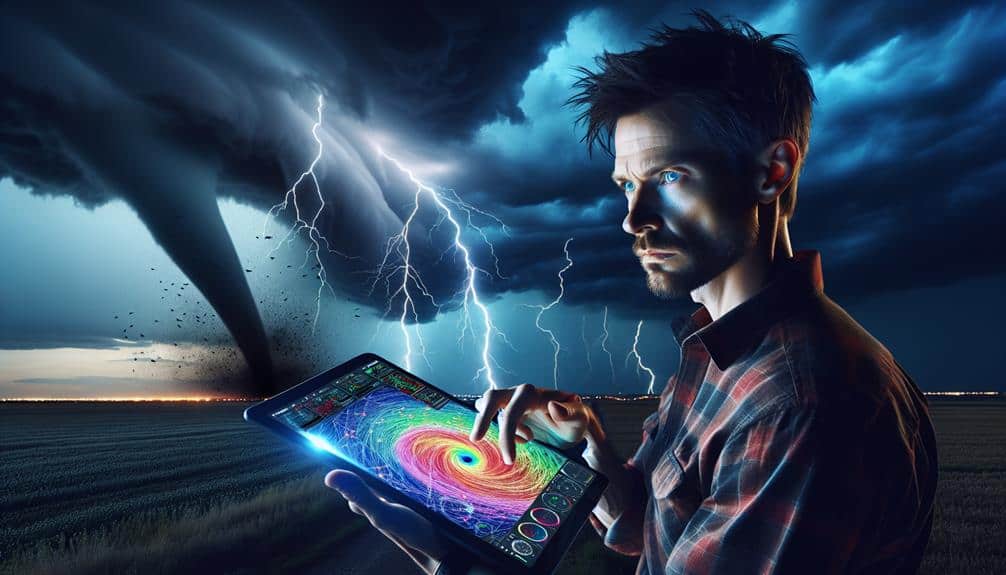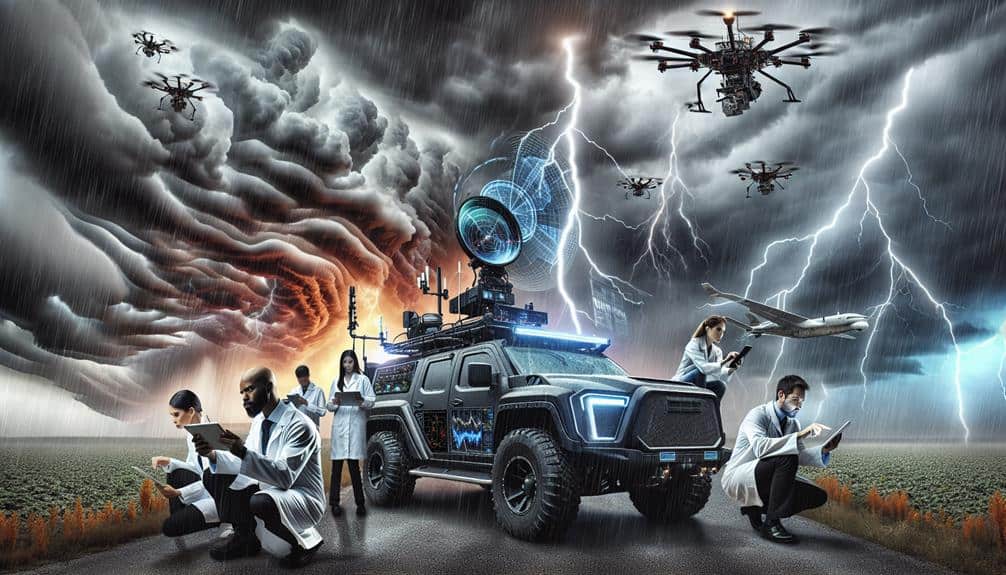As storm chasers, we must stay vigilant of five vital atmospheric trends to maximize our effectiveness: increasing tornado frequency, changing storm tracks, improved wind shear, rising ocean temperatures, and extreme rainfall patterns. We need to leverage advanced equipment like Doppler radar and portable weather stations for accurate data on these trends. Improved wind shear and rising ocean temperatures greatly amplify storm intensity, while changing storm tracks present new forecasting challenges. Finally, erratic extreme rainfall demands better predictive models to manage flood risks. By focusing on these trends, we can improve our strategies and safety measures in the field.
Key Points
- Tornado frequency is increasing, necessitating upgraded storm chaser equipment for better data accuracy and safety.
- Shifting storm tracks due to climate change require continuous adaptation in tracking methodologies and tools.
- Enhanced wind shear dynamics contribute to more intense and unpredictable storm systems, often leading to higher tornado occurrences.
- Rising ocean temperatures result in higher evaporation rates, fueling more intense and frequent storm events.
Increasing Tornado Frequency
In recent years, we've observed a marked increase in tornado frequency, calling for a closer examination of atmospheric conditions and patterns. This uptick demands that we, as storm chasers, upgrade our storm chaser equipment to enhance data accuracy and personal safety.
High-resolution Doppler radar systems and portable weather stations now play pivotal roles in tracking and analyzing tornadoes. These advanced tools allow us to collect real-time data on wind speed, humidity, and pressure variations, thereby refining our predictive models.
Nonetheless, the increase in tornado activity also highlights the importance of stringent safety precautions. Given the unpredictable nature of these storms, it's critical that our vehicles are equipped with reinforced structures and emergency supplies. Additionally, deploying GPS tracking ensures that we can maintain communication and receive timely updates on storm paths. Adhering to a well-rehearsed safety protocol, including predefined escape routes and frequent check-ins with local meteorological stations, is non-negotiable.
Ultimately, the combination of cutting-edge storm chaser equipment and rigorous safety precautions enables us to pursue our passion with a measure of security. As we navigate these increasingly frequent and severe weather events, our preparedness becomes our greatest asset.
Shifting Storm Tracks
Shifting storm tracks present new challenges and opportunities for storm chasers. These changes demand continuous adaptation in our tracking methodologies and equipment. With the increased influence of climate change impacts, storm track predictions have become more complex.
We must now consider altered atmospheric dynamics that affect the movement and intensity of storms. Our storm chasing strategies need to evolve to keep pace with these changes. Traditional patterns we once relied on may no longer apply, requiring us to incorporate more advanced predictive models that account for the shifting storm tracks.
This means leveraging enhanced satellite data, real-time weather updates, and sophisticated software tools to predict and track storm paths accurately. Understanding the atmospheric dynamics behind these shifts is essential. As climate change alters temperature gradients and jet stream patterns, storm tracks can deviate significantly from historical norms.
We must stay ahead of these changes to maximize both our safety and our ability to capture valuable data.
Enhanced Wind Shear
Enhanced wind shear presents both intricate challenges and unique opportunities for storm chasers, demanding a deeper understanding of its effects on storm development and behavior. Wind shear dynamics, defined by the variation in wind speed and direction with altitude, play a pivotal role in storm formation and intensity. When we analyze how wind shear influences these processes, we can better anticipate and navigate severe weather scenarios.
Effective forecasting techniques are indispensable for interpreting wind shear's impact. Advanced models now allow us to predict areas of enhanced wind shear with greater precision, enabling tactical decision-making in real-time. This knowledge empowers us to prepare adequately, ensuring both safety and success in our storm-chasing endeavors.
Consider the following impacts of enhanced wind shear on our storm-chasing activities:
- Intensified Storm Systems: Enhanced wind shear can lead to more robust and destructive storms, raising both the stakes and rewards.
- Increased Tornado Potential: Strong wind shear often correlates with higher tornado occurrences, providing more opportunities for observation and data collection.
Rising Ocean Temperatures
As ocean temperatures rise, we must analyze the resulting impact on atmospheric conditions and storm formation with an even greater level of detail. Warmer ocean surfaces contribute to increased evaporation rates, which in turn, injects more moisture into the atmosphere. This additional moisture fuels storm systems, often leading to more intense and prolonged events.
Additionally, the rise in sea temperatures is closely linked to ocean acidification, a process with far-reaching consequences. Ocean acidification affects marine ecosystems, potentially altering the food chain and impacting the frequency and intensity of tropical storms.
As storm chasers, understanding these shifts is vital for accurate storm prediction and tracking.
Climate change adaptation strategies are essential for mitigating the effects of rising ocean temperatures. We need to incorporate real-time ocean temperature data into our predictive models, enhancing our capability to foresee storm development and behavior.
Extreme Rainfall Patterns

Extreme rainfall patterns have become increasingly erratic, driven by the complex interplay of atmospheric moisture content and temperature fluctuations. As storm chasers, we must understand how these shifts affect rainfall distribution and flood risk.
Higher temperatures increase the atmosphere's capacity to hold moisture, leading to more intense and localized downpours. This means that the same storm system can produce vastly different rainfall amounts over short distances, complicating our predictions and responses.
Consider these emotional triggers:
- Lives and homes are at stake: Unpredictable floods can devastate communities.
- Our freedom to chase safely: Erratic patterns make it harder to plan safe chases.
The increased variability in rainfall distribution means we must be more vigilant and adaptive. Flood risk escalates as these intense rainfall events can overwhelm drainage systems and natural barriers. This necessitates better real-time data and predictive models to navigate these challenges.
Frequently Asked Questions
What Tools and Equipment Do Storm Chasers Typically Use?
We rely on equipment essentials like weather radios and tracking technology such as Doppler radar. Adhering to safety protocols, we carry emergency shelter options. This guarantees we can chase storms effectively while prioritizing our safety and freedom.
How Do Storm Chasers Ensure Their Safety During Severe Weather Events?
We secure our safety during severe weather events by following strict emergency protocols, wearing protective gear, and maintaining effective communication strategies. Our evacuation plans are well-rehearsed, guaranteeing quick responses to rapidly changing conditions, securing our freedom to explore.
What Qualifications Are Needed to Become a Professional Storm Chaser?
To become a professional storm chaser, we need a solid educational background in meteorology or atmospheric science, extensive experience in the field, specialized training, and relevant certifications. This combination guarantees we're prepared for the challenges ahead.
What Role Does Social Media Play in Modern Storm Chasing?
Social media's role in modern storm chasing is revolutionary. It enables citizen journalism, providing real-time updates. Community collaboration and online networking allow us to share data instantly, enhancing our freedom to chase and forecast storms more effectively.
How Do Storm Chasers Contribute to Scientific Research and Public Awareness?
We contribute to scientific research and public education by providing real-time data and insights. Our community engagement and media coverage enhance scientific impact, raising public awareness and fostering a more informed, proactive society.


